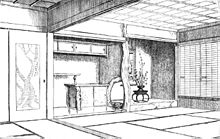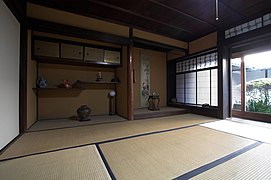Chigaidana

Chigaidana ( Japanese 違 い 棚 ) refers to a shelf in traditional Japanese houses that is used to present decorative objects. It consists of two asymmetrically arranged shelves, from which the name can be derived: chigai means "different" and tana means a shelf.
Usually the Chigaidana is located right next to the Tokonoma , a decorative bay window in representative rooms.
classification
Originally, shelves and cupboards were formed in representative rooms of Japanese houses for the purpose of storing personal items. With increasing popularity in buildings of the Japanese nobility, especially during the Shoin style in the 15th and 16th centuries, the Chigaidanas developed into decorative elements. They were now used to display valuable items such as tea bowls, vases or small storage boxes. Care was always taken to ensure that very few objects were to be found on the shelves.
The further developed idea of the chigaidana now largely corresponds to that of a tokonoma, the decorative bay window.
features
A chigaidana is always located next to the tokonoma and is spatially separated by a light wall ( 床柱 , tokobashira ). The central element is an asymmetrical configuration of two shelves that touch the surrounding walls. Both floors are connected by a thin vertical support ( 海 老 束 , ebizuka ). The lower floor bears the load of the upper one because the support is not continued on the floor. The upper floor is provided with a slight oscillation or edge ( 筆 返 し , fudegaeshi ) to prevent objects such as brushes from rolling down. The lower base dispenses with this feature. The configuration and the ratio of the asymmetry are supposed to be reminiscent of traditional images of clouds, which leads to a second, less well-known name. From time to time the shelves are also referred to as usukasumi-dana ( 薄 霞 棚 ), i.e. thin-fog shelves.
Above the thin shelves is a flat cupboard with two light sliding doors that are covered with paper. They are reminiscent of a Fusuma . Objects can be stored here and protected from prying eyes. This cabinet, also called tenbukuro ( 天 袋 ), touches the ceiling and thus appears to be part of it. The lowering of the ceiling height in the area of the Chigaidana leads to a changed feeling of space and additionally emphasizes the exhibited objects.
Occasionally one finds a similar cupboard above the floor, called oshi-ita ( 押 板 ). Its surface could serve as a desk.
In any case, the floor height in the area of the Chigaidana is slightly higher than in the rest of the room, but always shallower than in the neighboring Tokonoma bay. The ceiling is usually a bit flatter than that of the tokonoma, provided there are no upper cabinets ( tenbukuro ).
gallery
Chigaidana (left) with a smaller tokonoma
Individual evidence
- ↑ chigaidana 違 い 棚 . In: JAANUS. Retrieved September 3, 2017 .
- ^ Mira Locher, Traditional Japanese Architecture. An Exploration of Elements and Forms, p. 124, ISBN 978-4-8053-0980-3 , 2010
- ^ Mira Locher, Traditional Japanese Architecture. An Exploration of Elements and Forms, p. 125, ISBN 978-4-8053-0980-3 , 2010


